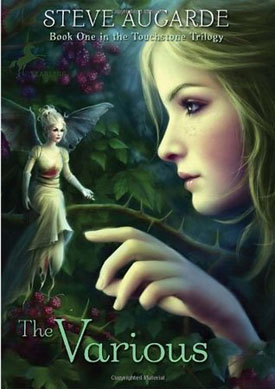 Steve Augarde is a well-known British illustrator and author of children’s books. The Various, the first in a series, treats the adventures of twelve-year-old Midge, sent to stay with her Uncle Brian at the old family farm in Somerset while her mother Christine, a professional violinist, is on tour with the orchestra. In spite of her initial resistance, Midge is won over: she finds the farm and Uncle Brian charming, even before she discovers that her bedroom is the room in which she was born. It looks as though she is in for a pleasant idyll for two weeks, when her cousins Kate and George will arrive for a visit, and then she discovers Pegs, a miniature winged horse, lying wounded in an old pig barn, trapped under a rotary rake.
Steve Augarde is a well-known British illustrator and author of children’s books. The Various, the first in a series, treats the adventures of twelve-year-old Midge, sent to stay with her Uncle Brian at the old family farm in Somerset while her mother Christine, a professional violinist, is on tour with the orchestra. In spite of her initial resistance, Midge is won over: she finds the farm and Uncle Brian charming, even before she discovers that her bedroom is the room in which she was born. It looks as though she is in for a pleasant idyll for two weeks, when her cousins Kate and George will arrive for a visit, and then she discovers Pegs, a miniature winged horse, lying wounded in an old pig barn, trapped under a rotary rake.
Pegs, who is a horse with a mission, guides Midge to the Royal Wood (she’s made up names for everything on the farm, but it turns out that the name she chose for the Wood is the name used by its inhabitants), where she meets the Various — five tribes of the Wee Folk, confined to the Wood by the encroachments of humans in the outer world. The soil has grown thin and they are trying to find a way out before they are faced with extinction. Circumstances are more serious than they imagine — Uncle Bruce has told Midge that he intends to sell the parcel that contains the Wood to a developer to make some money. Bruce has tried all sorts of ways to make the farm a paying proposition, but he’s not a farmer — nor is he a very good businessman.
Although there are sections that run a little slowly, this is an absorbing tale that does a great deal to investigate many issues for kids — or adults, for that matter. It is by no means sugar-coated: Midge’s relationship with her mother is problematic; Kate is at the age where the only things of interest are popularity and the latest fashions; George is a guy-in-the-making; Uncle Bruce, who is charming and has a way with people, is also fairly inept as most aspects of living; and the Various themselves are not all necessarily good or honorable. The degree of realism is certainly in keeping with most of the recent juvenile and young adult fiction that has passed across my desk, and one thing that is very welcome: Augarde gives the adults a chance to explain themselves, which is not the usual formula. The resolution of this story is excellent: Christine needs a break from the pressures of touring with the orchestra, and if Uncle Bruce is not a good businessman, Christine is, and the farm has a lot of potential, since the sale of the parcel is not going to go through — the planning board doesn’t want the Wood destroyed.
There is also a clear-eyed look at the Various, who become a lesson in tolerance and the appropriate use of authority. The characterizations are as vivid as those of the human actors in this story — some of them are more than a little appealing, and some of them are bad news from the word go. The romance between Little-Marten, the Woodpecker who summons the tribes to meetings, who is of the winged Ickri, hunters and explorers, and Henty, of the Troggles, who live in caves and make things of metal and are looked down on by the other tribes, is a charming thread that hints of great changes to come in the society of the Various.
There is enough foreshadowing of future events to set up the next two books in the trilogy, while the first volume is nicely resolved and exceptionally well-done. As an added bonus, I happen to love books in which authors make good use of dialect, and Augarde has the patterns of the West Country down pat.
The Various has a lot of charm, a lot of dramatic tension, some really scary places, and some very touching passages. Highly recommended.
(Yearling (Random House), 2004)
